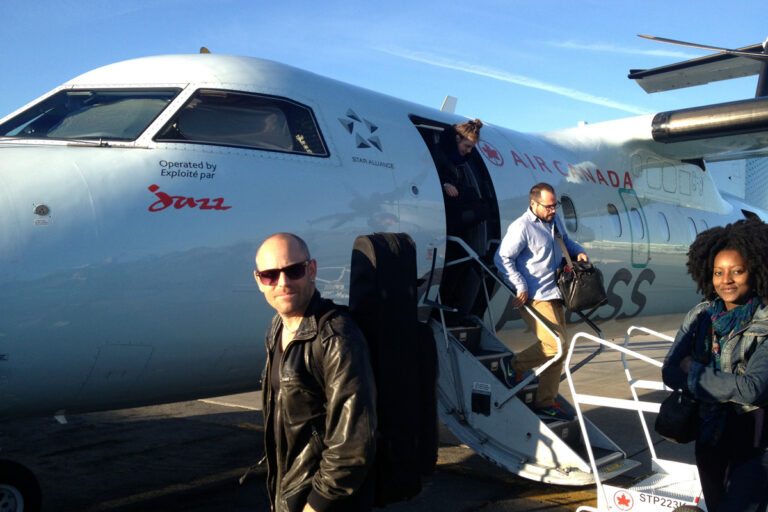“I use public transport when I am travelling for work purposes and often go through Zurich”, explains the composer and Schwyzerörgeli (diatonic button accordion used in Swiss folk music) virtuoso from Altendorf. “Travelling can be very inspiring. I make a note of my ideas, if possible, on my laptop or a piece of paper.”
Marcel Oetiker does also not believe that influences like those sounds have left their mark on the new Swiss folk music, the genre he is associated with. In his opinion, it’s more important that you study your type of music and then apply what you learned when you compose – “this makes it possible to open even this genre to a new perspective.”
From folk music to Jazz studies
Marcel Oetiker is a good example for this. The self-taught musician played traditional Landler music at a very young age and quickly rose in that scene. That way, he got to an area where you orientate yourself more on the music itself than its entertainment value.
“To extract a tangible maximum from a status quo which resists the many repetitions as long as possible – that was and is the level of folk music which fascinated me.” He has stuck to this approach until today.
He got to know new possibilities through his Jazz studies at the Berne University of Arts, which he completed with a Master in composition and theory. “Jazz offers much more differentiated harmonics and especially a theory model in order to be able to control and write down the various harmonic effects of music.” You can even hear a certain proximity to New Music at times, he would like to be able to use the entire spectrum of composition-related possibilities.
From notation to acoustic musical scores
 This has also changed the way Marcel Oetiker composes his works. He hardly bases his works on a classical motif because he does not want to linger in one specific composition style. That way, he moves away from the conventional notation and tries increasingly to “remain entirely on the acoustic level.” His approach is to provide performing artists an acoustic music score, for example, which he creates with instruments or sounds.
This has also changed the way Marcel Oetiker composes his works. He hardly bases his works on a classical motif because he does not want to linger in one specific composition style. That way, he moves away from the conventional notation and tries increasingly to “remain entirely on the acoustic level.” His approach is to provide performing artists an acoustic music score, for example, which he creates with instruments or sounds.
Marcel Oetiker also develops works for several musicians. “It is not like it is for a typical band, where you tinker on a piece together. The compositions emerge from specific events and are not always continuously annotated but may also include instructions.” Marcel Oetiker stresses that the pieces are nevertheless usually rather elaborate and don’t allow for a lot of leeway.
First the music, then the money
Marcel Oetiker is a professional musician. Apart from his composer activities, he conducts several ensembles and lectures in a variety of educational institutions. “If I had wanted to become rich quickly, I shouldn’t be active in such unusual music genres. I never intended to live off music – but for music.”
He therefore appreciates it even more that he can leave the management of his copyright to SUISA. “It takes a lot of administrative activities off my shoulders. That is exactly what I need in order tofocus even more on the music.” He has been particularly impressed by the advisory services. “I have always received a helpful answer when I approached SUISA with a question. And I have never got an invoice for this service – where else do you still get that?”
 “Where the music is new” “Where the music is new” The value of the ideas of music creators is the centrepiece of SUISA’s work. For the brochure “Where the music is new”, five personalities and bands from various musical genres and Swiss language regions provided insights into their artistic creation process and their musical activities. Apart from Marcel Oetiker, Camilla Sparksss, Oliver Waespi, Eriah and Carrousel will be presented via the SUISAblog.ch and in the brochure, first published in 2015. |





Finde das Gespräch interessant und spannend, leider finde ich die Bilder nicht optimal, wie z.B. Bildausschnitte, Kameraführung und Farben sind zu wenig ausgearbeitet und ausgesucht… Zum Teil auch sehr sehr wackelige Bilder, dass mehr Verwirrung stiftet als was anderes…
Bei der Mikrophonierung hätte ich Anstecker gewählt, die weniger Nebengeräusche aufnehmen. Wenn keine Vorhanden waren, dann hätte ich die Richt-Mikrophone nicht auf die Gleise gerichtet, da sobald ein Zug kommt, man ihn kaum mehr versteht, Zudem finde ich, gehören sie nicht ins Bild (es ist ja keine PK…) Vielleicht hätte es ein geeigneter Interview-Platz auch nicht schlecht getan…